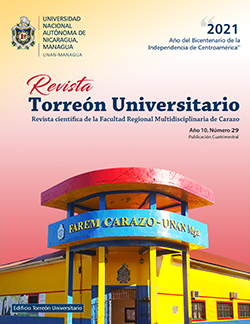Fluctuations of pH, alkalinity, dissolved oxygen and nutrient in Cayos Miskitos, municipality of Puerto Cabezas, Autonomous Region of the North Atlantic (RAAN)
DOI:
https://doi.org/10.5377/rtu.v10i29.12743Keywords:
Ocean acidification, alkalinity, nutrients, physical-chemical parametersAbstract
Ocean acidification is the drop in pH caused by the absorption of anthropogenic carbon dioxide produced by the combustion of fossil fuels, among other human activities, increasing the acidity of water and decreasing the availability of carbonates, which threatens the survival of Calcareous marine species: corals, oysters, crabs and lobsters, among others. These effects constitute a threat in the Nicaraguan Caribbean, so a monitoring of the physical-chemical parameters of the water was carried out in Cayos Miskitos (Puerto Cabezas, Autonomous Region of the North Atlantic, RAAN) in July, September and November 2018; February and March 2019. The samplings were carried out with the collaboration of IREMADES-URACCAN technicians. The physical-chemical parameters measured were: pH, total alkalinity, dissolved oxygen and nutrients; they were analyzed by standard methods. The pH presented normal values for seawater (8.05 and 8.19 pH units), while alkalinity showed values slightly above the typical values for seawater (118 to 124 mg/ l-1 as CaCO3). NTD concentrations at all sampled sites represented approximately 50% of NT concentrations, while the presence of FT, FTD and FRD is due to the phenomenon of outcrop to the surface of deeper waters. These results highlight the importance of studying pH and alkalinity to know its impact on the evolution of ocean acidification and its effects to support policies aimed at mitigating the phenomena of warming and adaptation to climate change.
Downloads
References
APHA. (2012). Standard Methods for the Examination of Water and Wastewater. Washington.
Bradley, P., Sandersona, M., Frischer, M., Brofft, J., Booth, M., Kerkhof, L., & Bronka, D. (2010). Inorganic and organic nitrogen uptake by phytoplankton and heterotrophic bacteria in the stratified Mid-Atlantic Bight. Estuarine, Coastal and Shelf Science , 429-441.
Brierley, A., & Kingsford, M. (2009). Impacts of climate change on marine organisms and ecosystems . Current Biology.
Bustos, H. (2003). Manual de Prácticas de Laboratorio en Oceanografía Química 2017-1. México .
Caldeira, K., & Wickett, M. (2003). Anthropogenic carbon and ocean pH. Nature, 365.
CCO. (2013). El Océano Maravilla Terrestre . Bogota D.C: Comisión Colombiana del Océano .
Cifuentes, J., Torres, M., & Frías, M. (1997). El Océano y sus recursos. II. Las ciencias del Mar: oceanografía geológica y oceanografía química. México .
CIMAB. (2010). Programa de monitoreo de la calidad de ecosistemas marinos en zonas de alto riesgo en la región del gran caribe. "Red regional en Ciencias y Tecnologías Marinas para el caribe: Know-Why Network". Nicaragua .
Comeaux, R., Mead, A., & Bianchi, T. (2012). Mangrove expansion in the Gulf of Mexico With climate change: Implications for wetland health and resistance to rising sea levels. Estuarine, Coastal and Shelf Science, 81-95.
Crumpton, W., Isenhart, T., & Mitchell, P. (1982). Nitrate an Organic N analisis with second derivate spectroscopiy. Limnology & Oceanography.
Custodio, E., & Llamas, M. (2001). Hidrología Subterránea. Tomo I y II. Barcelona, España : Omega, S. A.
De La Lanza Espino, G. (2001). Características fisico químicas de los mares de México. México: Editores México.
Delvalls, A. (1999). Underway pH measurements in upwelling conditions: The California Current. Ciencias Marinas, 345-365.
Gómez, A. (1996). Causas de la fertilidad marina en el nororiente de Venezuela . Interciencia , 140-146.
Humbolt, C. (2008). Monitoreo ambiental de sistemas productivos . Nicaragua .
IPCC. (2013). Climate Change 2013: The Physical Science Basis. New York, USA.
Jennerjahn, T. (2012). Biogeochemical response of tropical coastal systems to present and past environmental change. Earth Science Reviews, 19-41.
Karl, D., & Michael, L. (2003). Nitrogen Cycle. Encyclopedia of Ocean Sciences, 1876-1884.
Khatiwala, S., Primeau, F., & Hall, T. (2009). Reconstruction of the history antrhropogenic CO2 concentration in the ocean . Nature .
Margalef, R. (1991). Limnología. Ecología . Barcelona : Ediciones Omega. S, A .
Marsh, G. (2005). Seawater pH and anthropogenic carbon dioxide. Chicago: Argonne National Laboratory .
Porzio, L., Buia, M., & Hall, J. (2011). Effects of ocean acidification on macroalgal communities. Journal of Experimental Marine Biology and Ecology, 278-287.
Ramírez, A., & Viña, G. (1998). Limnología Colombiana aportes a su conocimiento y estadística de análisis . Colombia .
Waycott, M., Collier, C., McMahon, K., McKenzie, L., Udy, J., & Alana, G. (2007). Vulnerability of seagrasses in the Great Barrier Reef to climate change . Australia.
Published
How to Cite
Issue
Section
License
Copyright (c) 2021 Universidad Nacional Autónoma de Nicaragua, Managua

This work is licensed under a Creative Commons Attribution-NonCommercial-NoDerivatives 4.0 International License.
Los autores que publican en esta revista están de acuerdo con los siguientes términos.
- El autor o los autores de los artículos, ensayos o investigaciones conceden a la Universidad Nacional Autónoma de Nicaragua, Managua (UNAN-Managua) los derechos de edición (copyright) del trabajo enviado, por consiguiente la Universidad cuenta con el derecho exclusivo para publicar el artículo durante el periodo completo de los derechos de autor.
- Estos derechos de autor/ autores autorizan a la Revista Torreón Universitario y a la Universidad editar y divulgar/publicar el artículo en dicha Revista, incluyendo reproducción impresa y electrónica, el almacenamiento, recuperación y cualquier otro tipo de publicación, y fuentes de información secundaria como servicios de resúmenes y bases de datos, así mismo la facultan a proteger el artículo contra el uso no autorizado para su difusión por medios impresos o electrónicos (PDF, HTML, EPUB, XML u otros).
Licencia para el uso del contenido
La revista hace uso de la Licencia Creative Commons Atribución-NoComercial-SinDerivar 4.0 Internacional.
Bajo esta declaración:

Este revista está sujeta a una licencia de Creative Commons Reconocimiento-NoComercial-SinObraDerivada 4.0 Internacional. Puede ser copiada, distribuida y transmitida públicamente siempre y cuando se cite al autor y la fuente (Revista Torreón Universitario), no debe modificarse ni utilizarse con ningún fin comercial. La licencia completa se puede consultar en http://creativecommons.org/licenses/by-nc-nd/4.0/.

